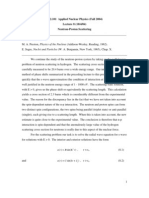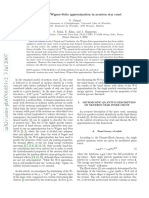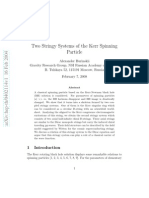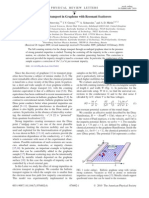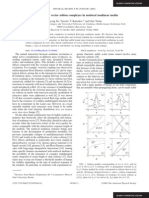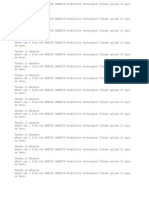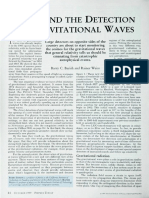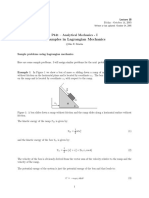L.O. Baksmaty Et Al - Tkachenko Waves in Rapidly Rotating Bose-Einstein Condensates
L.O. Baksmaty Et Al - Tkachenko Waves in Rapidly Rotating Bose-Einstein Condensates
Uploaded by
Pomac232Copyright:
Available Formats
L.O. Baksmaty Et Al - Tkachenko Waves in Rapidly Rotating Bose-Einstein Condensates
L.O. Baksmaty Et Al - Tkachenko Waves in Rapidly Rotating Bose-Einstein Condensates
Uploaded by
Pomac232Original Title
Copyright
Available Formats
Share this document
Did you find this document useful?
Is this content inappropriate?
Copyright:
Available Formats
L.O. Baksmaty Et Al - Tkachenko Waves in Rapidly Rotating Bose-Einstein Condensates
L.O. Baksmaty Et Al - Tkachenko Waves in Rapidly Rotating Bose-Einstein Condensates
Uploaded by
Pomac232Copyright:
Available Formats
Tkachenko Waves in Rapidly Rotating Bose-Einstein Condensates
L. O. Baksmaty, S. J. Woo, S. Choi, and N. P. Bigelow
Department of Physics and Astronomy, and Laboratory for Laser Energetics, University of Rochester,
Rochester, New York 14627, USA
(Received 15 July 2003; published 20 April 2004)
We present a mean-eld theory numerical study of Tkachenko waves of a vortex lattice in trapped
atomic Bose-Einstein condenstates. Our results show remarkable qualitative and quantitative agreement
with recent experiments at the Joint Institute for Laboratory Astrophysics. We extend our calculations
beyond the conditions of the experiment, probing deeper into the incompressible regime where we nd
excellent agreement with analytical results. In addition, bulk excitations observed in the experiment are
discussed.
DOI: 10.1103/PhysRevLett.92.160405 PACS numbers: 03.75.Kk, 32.80.Lg, 67.90.+z, 67.40.Vs
The dynamics of quantized vortices are important in a
wide variety of physical phenomena from turbulence to
neutron stars, to superconductivity and superuidity [1].
The broad relevance of this problem is partly responsible
for the current interest in vortex lattices in trapped Bose-
Einstein condensates (BECs). This system is also attrac-
tive because it can easily be manipulated and imaged
[25] and because the condensate is accurately described
within mean-eld theory [6]. Until recently much of the
progress made in the study of vortex arrays in neutral
superuids was in the context of
4
He. This system, how-
ever, is notoriously difcult to manipulate and control.
Vortex lattices in BECs have thus created an unprecen-
dented opportunity to study vortex matter in detail. This
has been recently demonstrated in spectacular experi-
ments at the Joint Institute for Laboratory Astrophysics
(JILA) in which Tkachenko waves as well as hydrody-
namic shape oscillations were directly observed [4]. In
this Letter we present a numerical study of these vortex
matter excitations. Our approach has the advantage that it
does not require any assumptions about the compressibil-
ity or homogeneity of the condensate.
In the limiting case of an incompressible irrota-
tional uid, Tkachenko waves are transverse vortex-
displacement waves traveling in the triangular lattice of
vortex lines which constitute the ground state of the
rotating superuid [7,8]. In this idealized situation, the
size of the vortex core is innitesimal and the dynamics
of the uid density may be ignored. For a simple illus-
tration, consider a system of n vortices each of circulation
k, in an irrotational, incompressible uid of density
contained by a vessel rotating at angular frequency . Let
vr represent the uid velocity at position r. If the
position of the |th vortex is labeled by a complex number
z
|
, the free energy (]) of the array in a frame rotating at
may be written as
]
k
2
4r
"
1
2
X
n
|1
X
n
]1
log}z
|
z
]
}
2
+
X
n
|1
(1 }z
|
}
2
)
#
.
(1)
Here we ignore the effects of the boundaries and the
energy associated with vortex cores [1,8]. By taking
into account the irrotational (\v 0) and in-
compressible (\ v 0) nature of the uid, we may
derive this expression from the simple classical relation
for the energy which in this case is purely kinetic: ]
R
j
1
2
vr
2
r v(r)|Jr. We can observe from Eq. (1)
that the vortex lattice, which represents a local minimum
of this free energy, results from a competition between
two terms: the logarithmic term which represents the
intervortex repulsion and the quadratic rotational term
which pulls the vortices towards the center. Tkachenko
waves are organized oscillations of the vortex positions
about this equilibrium. Microscopically, the vortices pre-
cess about their equilibrium position in elliptical orbits
against the trap rotation with the major axis perpendicu-
lar to the wave propagation. On the macroscopic scale, the
array is seen to undergo harmonic distortions which shear
the lattice and cause the rotation of the array to alter-
natively slow down and speed up.
Vortex arrays produced in rapidly rotating trapped
BECs depart from this idealized case in two important
aspects: the system is signicantly compressible and the
underlying uid is inhomogeneous. Because of nite
compressibility, it is important to consider the dynamics
of the underlying uid for an accurate treatment. This is
especially true in light of recent interest in lattices in the
mean-eld quantum Hall regime [9,10]. To date, most
vortex lattice studies rely on incompressible hydrody-
namic approximations [1,8,11]. The hydrodynamic ap-
proximation restricts the calculation to long wavelength
excitations and the assumption of incompressibility
ignores the dynamics of the uid density. Baym [12]
has recently demonstrated the importance of compressibl-
ity to the description of current experimental data. The
compressibility of the lattice may be gauged from the
ratio (
2
,e
2
. Here ( and e are the healing length and
intervortex distance, respectively. The healing length (
estimates the size of the vortex core. We dene these as
( 1,
8rno
_
and e
2
2r h,(
3
_
m) [6] , where o is the
P H YS I CA L R E VI E W L E T T E RS
week ending
23 APRIL 2004 VOLUME 92, NUMBER 16
160405-1 0031-9007,04,92(16),160405(4)$22.50 2004 The American Physical Society 160405-1
scattering length of the trapped species, n is the density at
the center of the condensate, m is the mass of the trapped
species, and is the angular frequency of the trap
rotation. In this Letter we bypass these familiar approxi-
mations by adopting a full numerical approach based on
mean-eld theory.
As an initial step we must construct the undisturbed
vortex array to a high degree of accuracy. We focus on the
excitations of triangular vortex arrays with hexagonal
symmetry, such as those obtained by recent experiments.
We work in a 2D geometry which is achieved by integrat-
ing out the axial (z) dependence assumed to be frozen in
the ground state of the harmonic oscillator. The coupling
constant g
3D
(4ro h
2
),m is renormalized to a quasi-
two-dimensional value g
2D
2rg
3D
,o
z
, where o
z
is the
oscillator length along the z axis dened in terms of the
axial trapping frequency w
z
by o
z
h,mw
z
p
. We note
that, owing to the centrifugal reduction in the radial trap
frequency w
r
, this is a reasonable assumption at high
rotation frequencies where most of our studies take place.
More importantly, this quasi-2D pancake geometry
has been experimentally justied by the high quality of
direct images of high [13] and low energy lattice excita-
tionsif the curvature of vortex lines were signicant,
such imaging would not be possible. According to the
T 0 mean-eld theory, the condensate wave function
(r, i) in a frame rotating with angular velocity
satises
| h
h
2
2m
\
2
+V(r) +Ng
2D
}}
2
L
z
, (2)
where w
r
is the radial trapping frequency, N is the number
of trapped atoms, and L
z
is the angular momentum op-
erator dened as | h
. The external potential V(r) is
dened as V(r)
1
2
mw
2
r
r
2
. The corresponding stationary
equation is solved using a steepest descent technique
starting from a triangular seed array. We denote the
ground state by
0
and dene its uctuation u
0
u(r)e
|wi
(r)
e
|wi
. Following the Bogoliubov
de Gennes procedure, a rst-order expansion around the
ground state in terms of u
0
then yields the eigenequa-
tion for the exciation amplitudes u
]
(r and
]
(r [6]:
H
+
]
g
2D
N(
0
)
2
u
]
w
]
]
,
H
u
]
g
2D
N
2
0
]
w
]
u
]
,
(3)
where H
(
^
hh
J
^
LL
z
+2g
2D
N}
0
}
2
), and
^
hh
J
h
2
2m
\
2
J
+
1
2
mw
2
J
r
2
is the single particle x-y Hamil-
tonian. We solve (3) with nite element methods [14] .
In this treatment we rely on a basic and venerable
mathematical principle: that the solution of
^
KK
l
l
l
is equivalent to minimizing (
l
,
l
)
R
l
^
KK
l
Jr,
R
}
l
}
2
Jr. We solve the variational problem by choosing
a trial function in a nite element basis. For this purpose,
the domain is broken up into pieces (elements) and on
each piece the sought function is approximated by a
polynomial. Let
h
l
and
h
l
be the eigenfunction and its
associated eigenvalue in this basis. We employ Hermite
cubics on square elements of length h, and on each
element we choose the 16 unknowns to be the values of
the sought function (
l
,
l
,x,
l
,x,
2
l
,xy) at
each of the four vertices. This choice ensures the con-
tinuity of the calculated eigenfunction
h
l
and its deriva-
tives listed above. If the operator
^
KK is bounded then we
can expect that as
h
l
-
l
,
h
l
-
l
. For a nite element
space of order k 1 it has been proved [14] that
h
l
l
ch
2(km)
, where c is a constant and m is the order of
the differential operator (in this case \
2
) in
^
KK. This gives
a bound on the error of the eigenvalues (
l
) of the operator
^
KK due to our projection of the eigenvectors
l
into a nite
element subspace. Another source of error arises from the
perturbation of the eigenvalue equation [Eqs. (3)] itself
due to the projection of the exact ground state
0
onto a
nite element subspace. For this error estimate we employ
a fundamental inequality of the nite element basis: on
each element, }
0
h
0
} C}
0
}
k
h
k
, where C is a con-
stant and }
0
}
k
P
1
+
2
k
R
}
k
0
x
1 y
2
}
2
. To ensure rea-
sonable accuracy, h must be small enough to capture
features over the three length scales that characterize
the lattice: the Thomas-Fermi radius R
TF
2
_
, the
healing length (, and the intervortex spacing e. This
prescription makes the problem very expensive and it
was not unusual to obtain sparse matrices of the order
10
5
10
5
. To solve such large eigensystems, we used a
variety of numerical libraries and visualization tools [15].
Unless otherwise stated, we express energy, length, and
time in the oscillator units hw
r
,
h,mw
r
p
, and 1,w
r
,
respectively.
Following Ref. [11], we represent a Tkachenko wave by
a complex valued function D
n,m
(r, i) e
|
j]
o
n,m
(r)
sin(mwi n) +|]
l
n,m
(r) cos(mwi n)|. The
integer pair (n, m) represents the radial and angular ex-
citation order, r (r, ), n is an arbitrary phase, and
]
o
n,m
(r), ]
l
n,m
(r) are real valued functions. The real and
imaginary parts of D
n,m
represent the displacement of a
vortex at r along the x and y axes, respectively, and every
vortex moves in an elliptical path.
A signicant challenge of comparing our numerical
calculation to experiment or to analytical results is the
proper identication of the excitations obtained. In our
calculation, the degree of freedom is the uctuation of the
eld amplitude u
0
, while in analytical work it is the
distortion D
n,m
of the vortex array that is employed. One
approach involves making movies of each excitation by
using u
0
u(r)e
|wi
(r)
e
|wi
. In Fig. 1 we show
snapshots from two such movies for the (1, 0) and (2, 0)
modes and compare them to experimental data. This
technique, however, has limitations. Even with a high-
resolution movie, the excitations are usually difcult to
tell apart by eye, especially as (
2
,e
2
grows, and also
P H YS I CA L R E VI E W L E T T E RS
week ending
23 APRIL 2004 VOLUME 92, NUMBER 16
160405-2 160405-2
because certain mode branches are very similar in ap-
pearance, e.g., the (n, 0) and (n, 6) branches. The experi-
mental identication of the excited mode relies on a sine
wave t to the expanded condenstate. The largely trans-
verseTkachenko waves become increasingly corrupted by
sound waves traveling in the underlying uid which scat-
ter off the vortices. A more rigorous approach involves
extracting D
n,m
from the uctuation u induced by a
particular excitation.
We therefore adopt a quantitative approach based upon
determining the instantaneous position of each vortex. A
coarse distortion function D
n,m
can then be constructed
by interpolating on the triangular lattice which species
the ground state. We show a typical result of this calcu-
lation in Fig. 2 for a (1, 0) mode in two arrays of similar
size but with signicantly different ratios of (
2
,e
2
. Along
any circle centered at the origin, r is constant and the
interpolated distortion D
n,m
denes a one-dimensional
function J(). The Fourier transform of e
|
J() then
yields a peak near the value m for the excitation labeled
by (n, m). This analysis reveals one important result: the
sense of precession of each vortex in an m 0 mode may
either be with or against the trap rotation. In these modes
the sense of precession of a vortex is a function of its
radial coordinate only, and along any circle all vortices
precess in the same sense. This is a dramatic departure
from the ideal situation of an array in a uniform, irrota-
tional, and incompressible uid. In that case, the vortices
precess only against the trap rotation. We note that this has
been analytically examined [16].
Our central result is illustrated by Fig. 3, where we
simultaneously make a quantitative comparision of our
computations with the JILA experiment [4] and with
recent analytic results for a stiff lattice [11]. We focus
on the (1, 0) mode. In the stiff regime, which is dened by
(
2
,e
2
-0, the speed of sound is much higher than the
typical response times of the lattice and the dynamics of
the uid density may be ignored. Here we obtain good
agreement with Ref. [11] (which corresponds to the value
1.0 in Fig. 3). We point out that it is not surprising that our
energies begin to exceed the analytic prediction as
(
2
,e
2
-0. In Ref. [11] the energy of this mode was
calculated to rst order in e. For small (
2
,e
2
, we consider
arrays for which e - 0.2 and for which higher order
terms in e could be important. At faster rotation and/or
lower particle densities the speed of sound lowers, the
parameter (
2
,e
2
increases (abscissa), and we enter the
soft regime in which the dynamics of the density is
important in the response of the lattice to disturbances.
Accordingly, we observe a quantitative deviation from
analytic results which is indistinguishable from that
experimentally reported [4]. In proportion to this quanti-
tative deviation, we nd that the eccentricity of the ellip-
tically polarized vortex oscillations in the Tkachenko
wave is reduced and the individual vortex motion be-
comes almost circular. We illustrate this trend in Fig. 2
[to be compared with Fig. 3(b) in Ref. [11]]. It is noted
that the vortex-displacement vectors in Fig. 2(b) have a
more signicant longitudinal projection than in Fig. 2(a)
in which the ratio (
2
,e
2
is almost an order of magnitude
larger.
In the limit of an incompressible uid, the potential
energy of the system is quenched and Tkachenko waves
emerge as the only nontrivial class of excitations of a
vortex array. However, they are just one of several types
of excitations which may occur within the compressible
vortex arrays realized in experiments [1]. Of particular
interest are the bulk (inertial) modes [12,17], some of
which can be very similar in appearance to Tkachenko
waves. In Ref. [4] the observation of a rapid mode which
FIG. 2. Calculated distortions of arrays with
(a) (
2
,e
2
0.007 and (b) (
2
,e
2
0.032 for a (1, 0) mode.
Solid circles: equilibrium vortex positions. Arrows: relative
vortex displacement.
FIG. 3. Energy of the (1, 0) mode versus (
2
,e
2
. In Ref. [11]
the energy of this mode is given as 1.43e. The height of the
plot symbols represents the error bars for both experiment and
theory. The estimate of computational error is described in the
text following Ref. [15].
FIG. 1. (a),(b) (1, 0) mode in action: (a) theory and
(b) experimental results. The curve is a tted sine wave with
wavelength 1.33R
TF
. (c),(d) (2, 0) mode in action: (c) theory
and (d) experimental results. The curves are drawn to guide
the eye.
P H YS I CA L R E VI E W L E T T E RS
week ending
23 APRIL 2004 VOLUME 92, NUMBER 16
160405-3 160405-3
is visually indistinguishable from the Tkachenko (1, 0)
mode is reported. We also idenitify such a mode at exactly
the experimentally reported value of 2.25this is just
the second-order bulk breathing or (2, 0) mode viewed in
a rotating frame. This identication also explains the
observations made in Ref. [18] in which the experimental
procedure of Refs. [4,13] was simulated. There, the fre-
quency of an excited breathing mode continuously
changed from -2.2 to 2.0 with the reduction of atom
removal at the center of the trap.
During each half of the oscillatory motion imposed on
the vortices by the breathing action in the (2, 0) bulk
mode, the transverse (Magnus) force acts in opposite
directions. On the microscopic level, elliptical motion of
the vortices is observed. Macroscopically, the array twists
around the center of rotation like a torsional pendulum as
the density breaths radially subject to the coriolis force.
We depict this second-order breathing mode in
Fig. 4(a). Surprisingly, the sine wave radial distortion
predicted [11] for the (1, 0) Tkachenko mode is also in
very good agreement with this (2, 0) bulk mode. To fur-
ther illustrate this point, we make use of the complex
density uctuation dened for the nth excitation by [6]
u (
0
u
n
0
). A casual comparision of the phase
of u for this mode in Fig. 4(b) with a schematic of the
experimental probe in Fig. 4(c) conrms the correct
identication of the mode excited in the experiment. A
close-up of this phase plot around the position of a vortex
is shown in Fig. 4(d). This describes a clockwise elliptical
oscillation of the density uctuation which has a local
peak at the vortex core. A similar motion of the vortex at
this site is implicated. We predict the existence of third-
and fourth-order breathing modes at 2.55 and 3.30, re-
spectively. This is a clear example of how the transverse
force and the coriolis force may blur the visual distinction
of the largely longitudinal modes from the transverse
Tkachenko waves [1]. Our computations have also uncov-
ered a third family of modes restricted to the surface of
the condensate and which manifest in the rotating frame
as a ring of vortices precessing the stationary ground
state [19].
We thank Michael Banks for valuable computing as-
sistance and G. S. Krishnaswami for insightful discus-
sions. We are also grateful to E. A. Cornell for permission
to present the JILA data and to J. Anglin and
M. Crescimanno for helpful correspondence. This work
is supported by DOE, NSF, ARO, and ONR.
[1] E. B Sonin, Rev. Mod. Phys. 59, 87 (1987).
[2] K.W. Madison, F. Chevy, W. Wohlleben, and J. Dalibard,
Phys. Rev. Lett. 84, 806 (2000).
[3] J. R. Abo-Shaeer, C. Raman, J. M. Vogels, and
W. Ketterle, Science 292, 476 (2001).
[4] I. Coddington, P. Engels, V. Schweikhard, and E. A.
Cornell, Phys. Rev. Lett. 91, 100402 (2003).
[5] V. Bretin, S. Stock, Y. Seurin, and J. Dalibard, Phys. Rev.
Lett. 92, 050403 (2004).
[6] A. L. Fetter and A. A. Svidzinsky, J. Phys. Condens.
Matter 13, R135 (2001).
[7] V. K. Tkachenko, Sov. Phys. JETP 23, 1049 (1966).
[8] L. J. Campbell, Phys. Rev. A 24, 514 (1981).
[9] Tin-Lun Ho, Phys. Rev. Lett. 87, 060403 (2001).
[10] V. Schweikhard, I. Coddington, P. Engels, V. P.
Morgendorff, and E. A. Cornell, Phys. Rev. Lett. 92,
040404 (2004).
[11] J. Anglin and M. Crescimanno, cond-mat/0210063.
[12] G. Baym, Phys. Rev. Lett. 91, 110402 (2003).
[13] P. Engels et al., Phys. Rev. Lett. 89, 100403 (2002).
[14] G. Strang and G. Fix, An Analysis of the Finite Element
Method (Prentice-Hall, Englewood Cliffs, NJ, 1973).
[15] L. O. Baksmaty (to be published).
[16] J. Anglin and M. Crescimanno (private communication).
[17] M. Cozzini and S. Stringari, Phys. Rev. A 67, 041602(R)
(2003); S. Choi, L. O. Baksmaty, S. J. Woo, and N. P.
Bigelow, Phys. Rev. A 68, 031605(R) (2003).
[18] T. P. Simula, A. A. Penckwitt, and R. J. Ballagh, Phys.
Rev. Lett. 92, 060401 (2004).
[19] L. O. Baksmaty, S. J. Woo, S. Choi, and N. P. Bigelow,
cond-mat/0310567.
FIG. 4. (a) Bulk (2, 0) mode in action. Overlaid curve is a sine
wave of wavelength 1.33R
TF
. (b) Phase plot of u. Notice the r
phase change as a node is radially crossed. (c) Experimental
atom removal region [4]. (d) Close-up of (b) on a vortex
location. In all phase plots, phase changes from 0 to 2r as
one goes from dark to light regions.
P H YS I CA L R E VI E W L E T T E RS
week ending
23 APRIL 2004 VOLUME 92, NUMBER 16
160405-4 160405-4
You might also like
- Ajna - Human DesignDocument11 pagesAjna - Human DesignT100% (11)
- Neutron Proton ScatteringDocument7 pagesNeutron Proton ScatteringDebayan DasguptaNo ratings yet
- Writing The Natural Way-2Document2 pagesWriting The Natural Way-2alansi92004100% (1)
- José Ortega y Gasset What Is KnowledgeDocument266 pagesJosé Ortega y Gasset What Is Knowledgeviya cowi100% (7)
- Lost in TranslationDocument6 pagesLost in TranslationAli Al-HalawaniNo ratings yet
- Stable Charged-Particle Acceleration and Focusing in A Laser Accelerator Using Spatial HarmonicsDocument5 pagesStable Charged-Particle Acceleration and Focusing in A Laser Accelerator Using Spatial HarmonicsParticle Beam Physics LabNo ratings yet
- Rayleigh-Taylor Instability in Variable Density Swirling FlowsDocument8 pagesRayleigh-Taylor Instability in Variable Density Swirling FlowsRebecca ClarkNo ratings yet
- Polar EigenstatesDocument11 pagesPolar EigenstatesPeter MuysNo ratings yet
- Kuramoto 1984Document18 pagesKuramoto 1984Lambu CarmelNo ratings yet
- S. Choi Et Al - Excitation Spectrum of Vortex Lattices in Rotating Bose-Einstein CondensatesDocument4 pagesS. Choi Et Al - Excitation Spectrum of Vortex Lattices in Rotating Bose-Einstein CondensatesLomewcxNo ratings yet
- Validity of The Wigner-Seitz Approximation in Neutron Star CrustDocument8 pagesValidity of The Wigner-Seitz Approximation in Neutron Star Crustvladimirkulf2142No ratings yet
- Sergey K. Nemirovskii and Makoto Tsubota - Trial Distribution Functional of Vortex Tangle in Superfluid HeliumDocument2 pagesSergey K. Nemirovskii and Makoto Tsubota - Trial Distribution Functional of Vortex Tangle in Superfluid HeliumJuaxmawNo ratings yet
- The Radially Vibrating Spherical Quantum BilliardDocument12 pagesThe Radially Vibrating Spherical Quantum BilliardJosé Rojas OlavarríaNo ratings yet
- Progress in Electromagnetics Research M, Vol. 28, 273-287, 2013Document15 pagesProgress in Electromagnetics Research M, Vol. 28, 273-287, 2013Tommy BJNo ratings yet
- Yuan-Xiu Miao Et Al - Coexisting Condensates of Weakly Interacting Bose Gas in A Harmonic TrapDocument5 pagesYuan-Xiu Miao Et Al - Coexisting Condensates of Weakly Interacting Bose Gas in A Harmonic TrapQMDhidnwNo ratings yet
- Matt Visser - Traversable Wormholes: Some Simple ExamplesDocument7 pagesMatt Visser - Traversable Wormholes: Some Simple ExamplesRtpomNo ratings yet
- Horace T. Crogman and William G. Harter - Frame Transformation Relations For Fluxional Symmetric Rotor DimersDocument12 pagesHorace T. Crogman and William G. Harter - Frame Transformation Relations For Fluxional Symmetric Rotor DimersKiomaxNo ratings yet
- Structural Studies of Decaying Fluid Turbulence: Effect of Initial ConditionsDocument9 pagesStructural Studies of Decaying Fluid Turbulence: Effect of Initial ConditionssolvenseNo ratings yet
- Late Time Cosmological Phase Transition and Galactic Halo As Bose-LiquidDocument4 pagesLate Time Cosmological Phase Transition and Galactic Halo As Bose-LiquidJ Christian OdehnalNo ratings yet
- David Luckhaus - From High Resolution Spectroscopy To Detailed Molecular Quantum DynamicsDocument8 pagesDavid Luckhaus - From High Resolution Spectroscopy To Detailed Molecular Quantum DynamicsMaxnamewNo ratings yet
- Experimental Investigation of The PlungeDocument22 pagesExperimental Investigation of The PlungePrakash Duraisamy CITNo ratings yet
- Maze Et Al RCD2004Document21 pagesMaze Et Al RCD2004Guillaume100% (1)
- C. Ruth Le Sueuer Et Al - On The Use of Variational Wavefunctions in Calculating Vibrational Band IntensitiesDocument10 pagesC. Ruth Le Sueuer Et Al - On The Use of Variational Wavefunctions in Calculating Vibrational Band IntensitiesPassammNo ratings yet
- Alexander Burinskii - Two Stringy Systems of The Kerr Spinning ParticleDocument22 pagesAlexander Burinskii - Two Stringy Systems of The Kerr Spinning ParticleSteam29No ratings yet
- Packets Kepler Elliptic Orbits: Quantum OnDocument4 pagesPackets Kepler Elliptic Orbits: Quantum OnggutierrezdieckNo ratings yet
- 2013 - PRB. Quantum Cloaking Based On Scattering CancellationDocument6 pages2013 - PRB. Quantum Cloaking Based On Scattering CancellationDiego OliverNo ratings yet
- K Kleidis Et Al - Imprints of Cosmic Strings On The Cosmological Gravitational Wave BackgroundDocument8 pagesK Kleidis Et Al - Imprints of Cosmic Strings On The Cosmological Gravitational Wave BackgroundLopmazNo ratings yet
- Carlos Barcelo and Matt Visser - Traversable Wormholes From Massless Conformally Coupled Scalar FieldsDocument11 pagesCarlos Barcelo and Matt Visser - Traversable Wormholes From Massless Conformally Coupled Scalar FieldsCoy668No ratings yet
- Zitterbewegung ExperimentDocument5 pagesZitterbewegung ExperimentAdonai CruzNo ratings yet
- S. Wuster, T.E. Argue and C.M. Savage - Numerical Study of The Stability of Skyrmions in Bose-Einstein CondensatesDocument8 pagesS. Wuster, T.E. Argue and C.M. Savage - Numerical Study of The Stability of Skyrmions in Bose-Einstein CondensatesPomac232No ratings yet
- Gain and The Threshold of Three-Dimensional Quantum-Box LasersDocument7 pagesGain and The Threshold of Three-Dimensional Quantum-Box LasersNitika GuptaNo ratings yet
- T. Kimura, Prog. Theor. Phys. 42, 1191 (1969) .Document15 pagesT. Kimura, Prog. Theor. Phys. 42, 1191 (1969) .ZaraNo ratings yet
- Symmetries and The Cosmological Constant PuzzleDocument11 pagesSymmetries and The Cosmological Constant PuzzleBlagojeNo ratings yet
- A Brief Overview of Existence Results and Decay Time Estimates For A Mathematical Modeling of Scintillating CrystalsDocument40 pagesA Brief Overview of Existence Results and Decay Time Estimates For A Mathematical Modeling of Scintillating CrystalsFabrizio DavìNo ratings yet
- Resonant Transport in Coupled Quantum Wells: A Probe For Scattering MechanismsDocument10 pagesResonant Transport in Coupled Quantum Wells: A Probe For Scattering MechanismsBayer MitrovicNo ratings yet
- Frozen TurbulenceDocument7 pagesFrozen Turbulencealireza.p1983No ratings yet
- tmp6D21 TMPDocument9 pagestmp6D21 TMPFrontiersNo ratings yet
- 2008 - PRL. Cloaking of Matter WavesDocument4 pages2008 - PRL. Cloaking of Matter WavesDiego OliverNo ratings yet
- Solar Neutrinos, Helicity Effects and New Affine Gravity With TorsionDocument18 pagesSolar Neutrinos, Helicity Effects and New Affine Gravity With TorsionBayer MitrovicNo ratings yet
- A Note On The Geometry of The Quantum StatesDocument15 pagesA Note On The Geometry of The Quantum StatescxhbrbshjfNo ratings yet
- Vortices and The Berezinskii Kosterlitz Thouless TransitionDocument9 pagesVortices and The Berezinskii Kosterlitz Thouless TransitionAdam AhmedNo ratings yet
- Brian T. Sutcliffe and Jonathan Tennyson - Variational Methods For The Calculation of Rovibrational Energy Levels of Small MoleculesDocument12 pagesBrian T. Sutcliffe and Jonathan Tennyson - Variational Methods For The Calculation of Rovibrational Energy Levels of Small MoleculesTreaxmeANo ratings yet
- Takashi Ishihara, Kyo Yoshida and Yukio Kaneda - Anisotropic Velocity Correlation Spectrum at Small Scales in A Homogeneous Turbulent Shear FlowDocument4 pagesTakashi Ishihara, Kyo Yoshida and Yukio Kaneda - Anisotropic Velocity Correlation Spectrum at Small Scales in A Homogeneous Turbulent Shear FlowPonmijNo ratings yet
- Dynamical Superfluid-Insulator Transition in A Chain of Weakly Coupled Bose-Einstein CondensatesDocument5 pagesDynamical Superfluid-Insulator Transition in A Chain of Weakly Coupled Bose-Einstein CondensatescdcrossroaderNo ratings yet
- Bryan Eisenhower and Igor Mezic - Targeted Activation in Deterministic and Stochastic SystemsDocument10 pagesBryan Eisenhower and Igor Mezic - Targeted Activation in Deterministic and Stochastic SystemsYidel4313No ratings yet
- Two-Fluid Dark Matter Models: PACS Numbers: 04.50.Kd, 04.20.Cv, 04.20.fyDocument6 pagesTwo-Fluid Dark Matter Models: PACS Numbers: 04.50.Kd, 04.20.Cv, 04.20.fyClaudio Cofré MansillaNo ratings yet
- PhononDocument9 pagesPhononChristopher BrownNo ratings yet
- X-Ray Diffraction by Time-Dependent Deformed Crystals: Theoretical Model and Numerical AnalysisDocument19 pagesX-Ray Diffraction by Time-Dependent Deformed Crystals: Theoretical Model and Numerical AnalysisPalash SwarnakarNo ratings yet
- Francesca Maggioni and Renzo L. Ricca - Writhing and Coiling of Closed FilamentsDocument16 pagesFrancesca Maggioni and Renzo L. Ricca - Writhing and Coiling of Closed FilamentsVortices3443No ratings yet
- HD Kolmogorov TheoryDocument14 pagesHD Kolmogorov TheoryFrancis GonzalezNo ratings yet
- PinheiroBuker EPL PDFDocument6 pagesPinheiroBuker EPL PDFMario J. PinheiroNo ratings yet
- On Free and Forced Vibration of Beam-Strings Using Wave-Based Transfer MatricesDocument34 pagesOn Free and Forced Vibration of Beam-Strings Using Wave-Based Transfer MatricesSoumyajit RoyNo ratings yet
- 國內填海造陸背填料防漏設計案例探討Document14 pages國內填海造陸背填料防漏設計案例探討喬誌江No ratings yet
- Hibp AspectsDocument50 pagesHibp Aspectsdebjyotibasu.basuNo ratings yet
- Rayleigh Scattering of Light in Glasses: E. E. A. M. Yu. F. A. V. SDocument8 pagesRayleigh Scattering of Light in Glasses: E. E. A. M. Yu. F. A. V. SOrhan VeliNo ratings yet
- Charge Transport in Graphene With Resonant Scatterers: Week Ending 19 FEBRUARY 2010Document4 pagesCharge Transport in Graphene With Resonant Scatterers: Week Ending 19 FEBRUARY 2010Iván RoaNo ratings yet
- Gravitational Waves in Open de Sitter SpaceDocument17 pagesGravitational Waves in Open de Sitter SpaceKaustubhNo ratings yet
- S.Wang Et Al - Two-Particle Separation in The Point Vortex Gas Model of Superfluid TurbulenceDocument13 pagesS.Wang Et Al - Two-Particle Separation in The Point Vortex Gas Model of Superfluid TurbulenceJuaxmawNo ratings yet
- Measuring The Super Fluid Fraction of An Ultracold Atomic Gas NR Cooper 2009Document4 pagesMeasuring The Super Fluid Fraction of An Ultracold Atomic Gas NR Cooper 2009sm794No ratings yet
- Tmpe286 TMPDocument5 pagesTmpe286 TMPFrontiersNo ratings yet
- Interpretation of Transverse Tune Spectra in A Heavy-Ion Synchrotron at High IntensitiesDocument14 pagesInterpretation of Transverse Tune Spectra in A Heavy-Ion Synchrotron at High Intensitiescampal123No ratings yet
- Hiroko Koyama and Sean A. Hayward - Construction and Enlargement of Traversable Wormholes From Schwarzschild Black HolesDocument22 pagesHiroko Koyama and Sean A. Hayward - Construction and Enlargement of Traversable Wormholes From Schwarzschild Black HolesKunma050No ratings yet
- Lecture16 Roger 136604Document9 pagesLecture16 Roger 136604Sanhita DasNo ratings yet
- Problems in Quantum Mechanics: Third EditionFrom EverandProblems in Quantum Mechanics: Third EditionRating: 3 out of 5 stars3/5 (2)
- Cheng-Lin Bai Et Al - Interactions Among Peakons, Dromions, and Compactons in (2+1) - Dimensional SystemDocument1 pageCheng-Lin Bai Et Al - Interactions Among Peakons, Dromions, and Compactons in (2+1) - Dimensional SystemPomac232No ratings yet
- Petja Salmi - OscillonsDocument192 pagesPetja Salmi - OscillonsPomac2320% (1)
- Noah Graham - An Introduction To Solitons and OscillonsDocument23 pagesNoah Graham - An Introduction To Solitons and OscillonsPomac232No ratings yet
- Alison Drain - Laposky's Lights Make Visual MusicDocument2 pagesAlison Drain - Laposky's Lights Make Visual MusicPomac232No ratings yet
- Gyula Fodor Et Al - Oscillons in Dilaton-Scalar TheoriesDocument31 pagesGyula Fodor Et Al - Oscillons in Dilaton-Scalar TheoriesPomac232No ratings yet
- Localized Structures in A Nonlinear Wave Equation Stabilized by Negative Global Feedback: One-Dimensional and Quasi-Two-Dimensional KinksDocument18 pagesLocalized Structures in A Nonlinear Wave Equation Stabilized by Negative Global Feedback: One-Dimensional and Quasi-Two-Dimensional KinksPomac232No ratings yet
- Arik Yochelis, John Burke and Edgar Knobloch - Reciprocal Oscillons and Nonmonotonic Fronts in Forced Nonequilibrium SystemsDocument4 pagesArik Yochelis, John Burke and Edgar Knobloch - Reciprocal Oscillons and Nonmonotonic Fronts in Forced Nonequilibrium SystemsPomac232No ratings yet
- Zhiyong Xu, Yaroslav V. Kartashov and Lluis Torner - Stabilization of Vector Soliton Complexes in Nonlocal Nonlinear MediaDocument4 pagesZhiyong Xu, Yaroslav V. Kartashov and Lluis Torner - Stabilization of Vector Soliton Complexes in Nonlocal Nonlinear MediaPomac232No ratings yet
- Physics Catapult ProjectDocument3 pagesPhysics Catapult Projectapi-386610371No ratings yet
- Balajit Nath Pandita-Specific Principles of Kashmir Saivism-Munshiram Manoharlal Publishers (1998) PDFDocument228 pagesBalajit Nath Pandita-Specific Principles of Kashmir Saivism-Munshiram Manoharlal Publishers (1998) PDFvramaniitk100% (2)
- BHRIGU SAMHITA Predictive TechniquesDocument6 pagesBHRIGU SAMHITA Predictive TechniquesPrince PatelNo ratings yet
- 2020 JAHHvol 23 No 3 CompleteDocument284 pages2020 JAHHvol 23 No 3 CompletekowunnakoNo ratings yet
- LIGO and The Detection of Gravitational Waves (Barry Barish and Rainer Weiss, Physics Today, 52, 10, 44 (1999) )Document7 pagesLIGO and The Detection of Gravitational Waves (Barry Barish and Rainer Weiss, Physics Today, 52, 10, 44 (1999) )ShubhodeepNo ratings yet
- 02 - Roskies Neuroscientific Challenges To Free Will and ResponsibilityDocument5 pages02 - Roskies Neuroscientific Challenges To Free Will and ResponsibilityzczcjunkNo ratings yet
- CLS Aipmt 15 16 XIII Phy Study Package 1 Set 1 Chapter 3Document46 pagesCLS Aipmt 15 16 XIII Phy Study Package 1 Set 1 Chapter 3divyashishtomar57% (21)
- Method of SatyAcharya LongevityDocument11 pagesMethod of SatyAcharya LongevityAnonymous jGdHMEODVmNo ratings yet
- Science and Civilisation in China Needham 3 - 2 PDFDocument501 pagesScience and Civilisation in China Needham 3 - 2 PDFКалин КонстантинNo ratings yet
- Atomic Theory ModelsDocument6 pagesAtomic Theory Modelsapi-318918663No ratings yet
- Relative Clauses WorksheetDocument4 pagesRelative Clauses WorksheetGozen CaktiNo ratings yet
- Physical Science S1112PS IIIa 2Document7 pagesPhysical Science S1112PS IIIa 2L LawlietNo ratings yet
- Climate Responsive ArchitectureDocument178 pagesClimate Responsive Architecturevinitvishujha100% (3)
- 27 Lunar Mansions 1Document6 pages27 Lunar Mansions 1Gaurav Panchal100% (1)
- Physics Project: Particle PhysicsDocument22 pagesPhysics Project: Particle PhysicsTJ0% (1)
- Cognitive GrammarDocument14 pagesCognitive GrammarMonika Tomac100% (3)
- David Myatt: The Philosophy of The NumenDocument39 pagesDavid Myatt: The Philosophy of The NumenNuminousway100% (1)
- Phillip G. Wiener - Dictionary of The History of Ideas - Studies of Selected Pivotal Ideas. 4-Charles Scribner's Sons (1973) PDFDocument544 pagesPhillip G. Wiener - Dictionary of The History of Ideas - Studies of Selected Pivotal Ideas. 4-Charles Scribner's Sons (1973) PDFJuanNo ratings yet
- Planetary Occupations in A HoroscopeDocument3 pagesPlanetary Occupations in A Horoscopeaddicts100No ratings yet
- 9702 s14 QP 12Document32 pages9702 s14 QP 12stopidNo ratings yet
- Quasi ParticleDocument6 pagesQuasi ParticleTeka KamNo ratings yet
- Global Navigation Satellite Systems I To 13Document167 pagesGlobal Navigation Satellite Systems I To 13smith858No ratings yet
- Lec 18Document6 pagesLec 18Anonymous rn2qoBPjKyNo ratings yet
- Dividing The SkyDocument37 pagesDividing The SkySivaPrasadNo ratings yet
- Gauss's and Laplace's Orbit Determination Methods and The Hunt For Least SquaresDocument28 pagesGauss's and Laplace's Orbit Determination Methods and The Hunt For Least SquaresMelody Dodd100% (1)
- Nine Star KiDocument128 pagesNine Star KishaukijameelNo ratings yet

